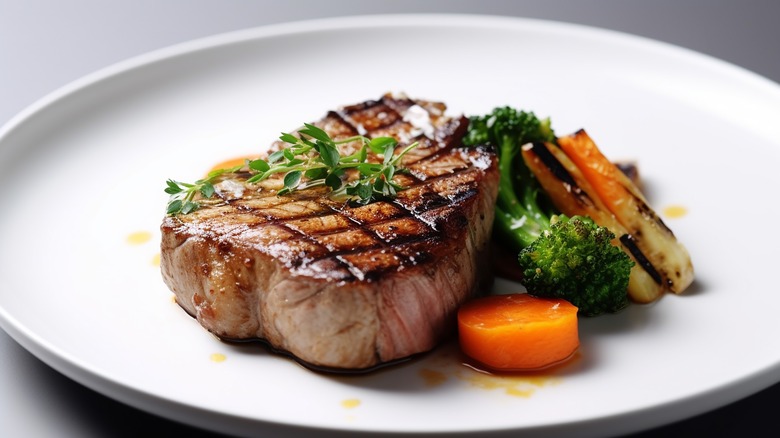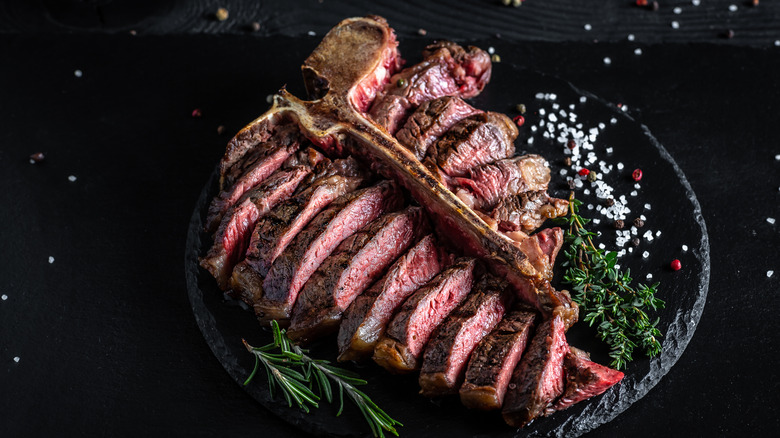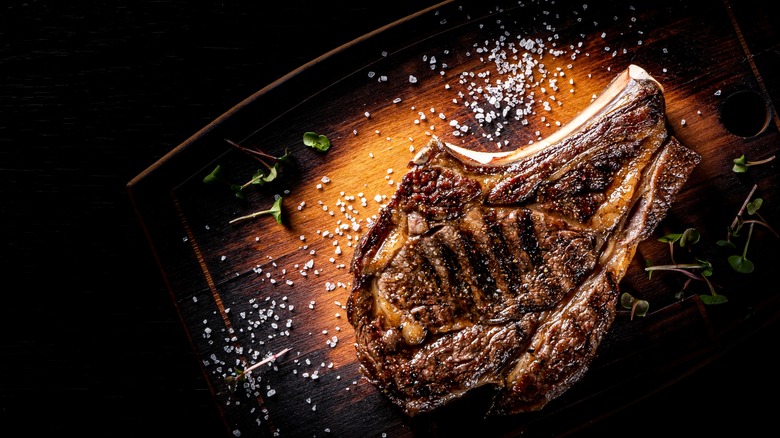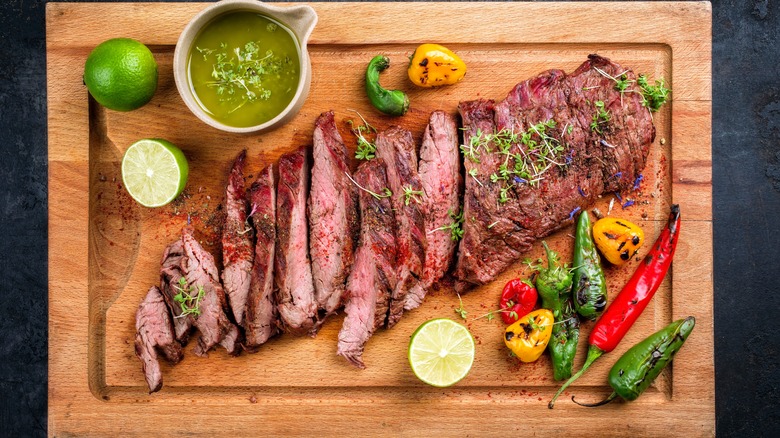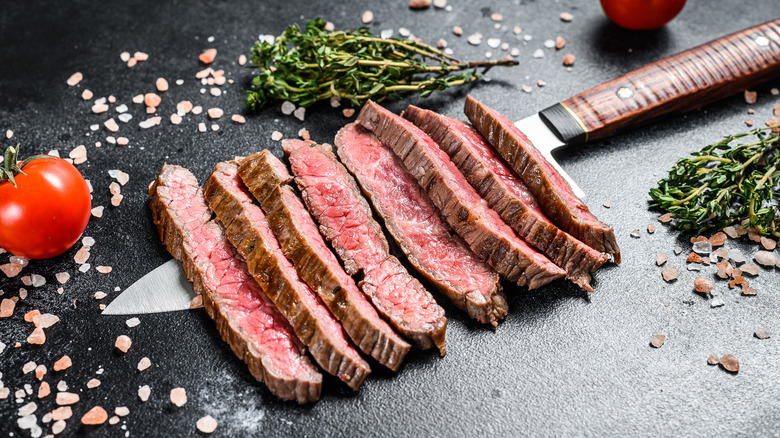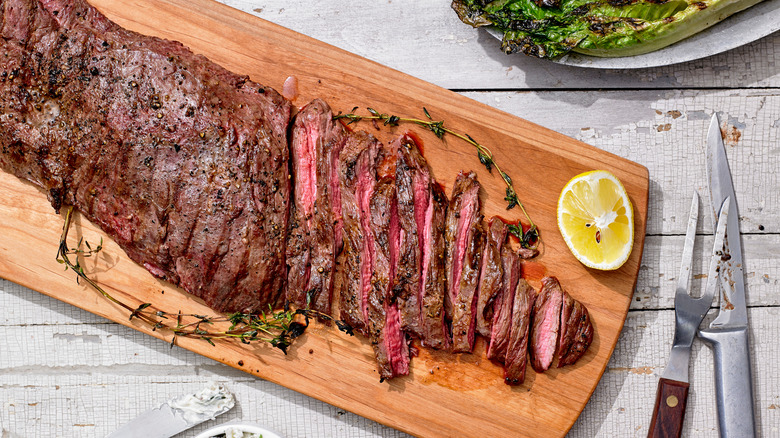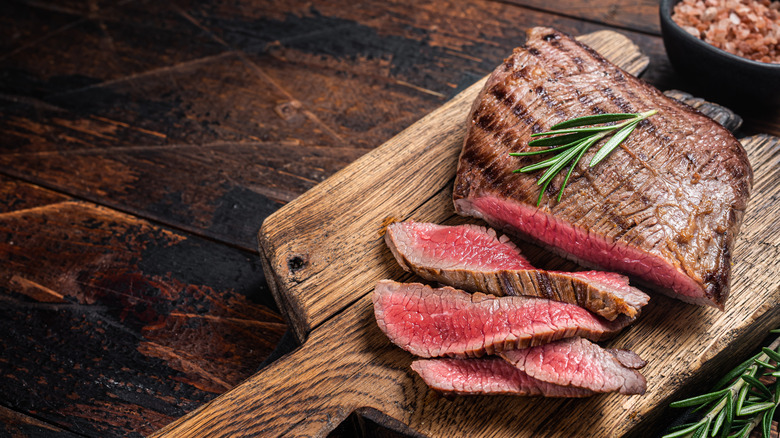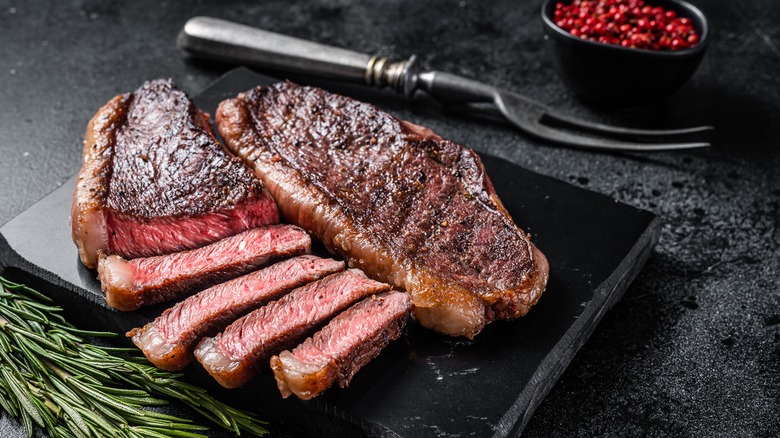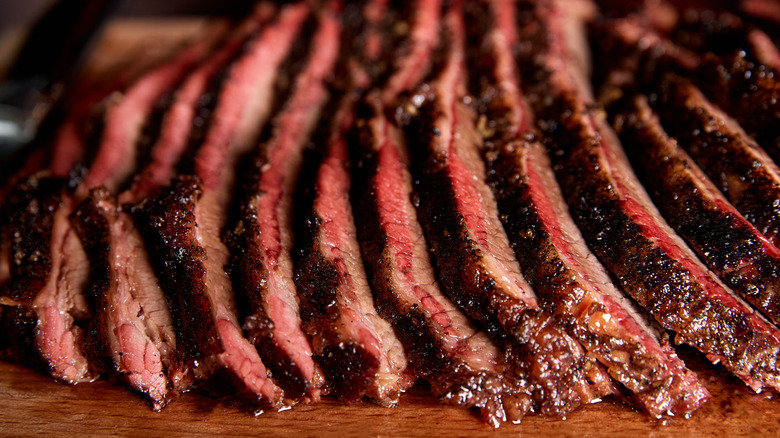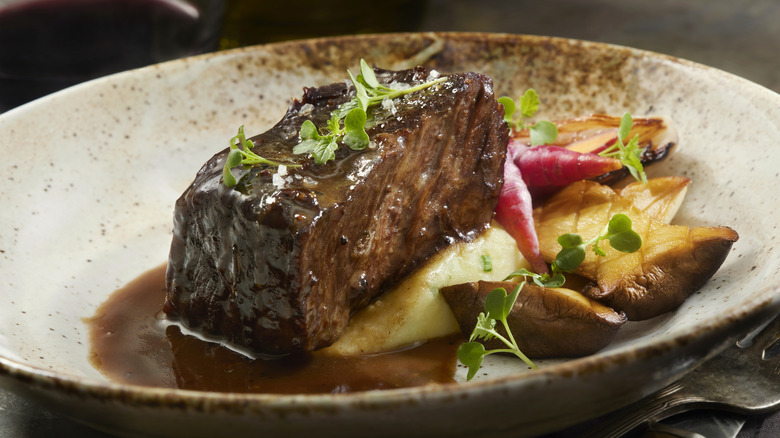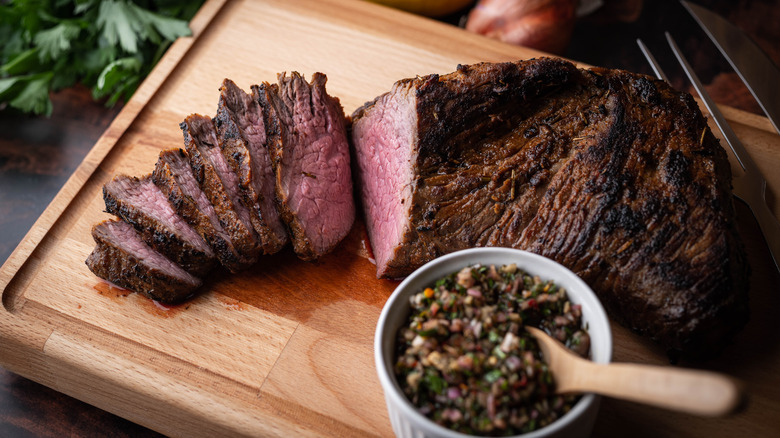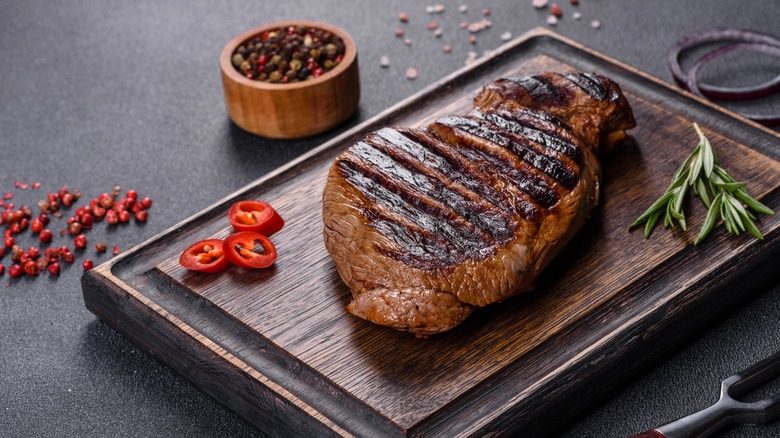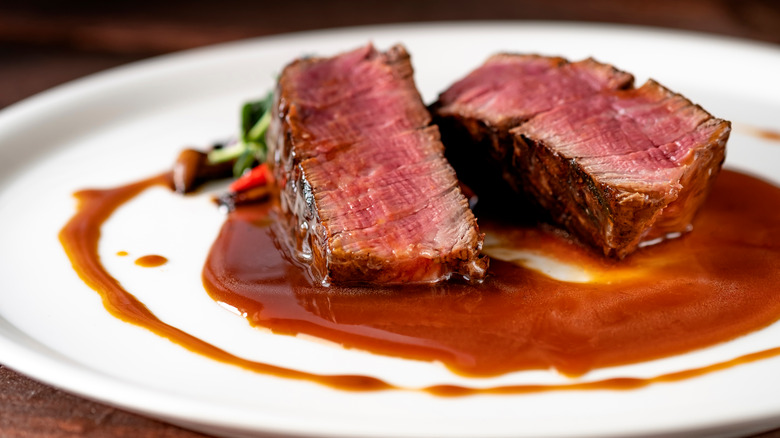The Best Cuts Of Steak For A Dinner Party
Hosting a dinner party for friends or family can be a daunting experience if it isn't something you do regularly. Among the more critical decisions you'll make is deciding on the menu. Steak is always a classy, elegant option that is a crowd-pleaser for carnivores. Choosing what kind of steak to serve may take a little more thought based on your budget, confidence level with cooking it, and the time you have to focus on doting over your beef.
While some cuts are always sure to dazzle, you don't have to break the bank to please your guests. There are plenty of options that are affordable and can impress even the most sophisticated of diners. The key is understanding what makes each cut unique, how to prepare it, and what sauces and sides to serve with them. That's where I come in. As a chef, I have hosted hundreds of steak dinners, and I know which cuts will fit the bill for your next event.
There are a couple of basics to keep in mind. Don't be afraid to buy meat in bulk or on sale. When it comes to accommodating myriad preferences regarding the doneness of your meat, err on the side of preparing your steaks medium-rare. You can cook them further for those wanting them more well-done, but you cannot uncook one. Read on for a list of the crème de la crème of cuts for the classiest carnivorous celebration of your life.
Porterhouse
The biggest thing a porterhouse has going for it is its size. At an average of 24 ounces per steak, this hunk of meat can easily feed two to three people, depending on what else you intend to serve. The other advantage is that it is a composite steak, which means it has two different sections. One side of this cut is a filet mignon, while the other is a New York strip. This gives you the option of offering your guests a sample of each or giving the choice between one or the other.
A porterhouse is cut from the back end of the short loin. Meat from this region of the cow is exceedingly tender because it does not get a lot of exercise. The two sections of the porterhouse are divided by a T-shaped bone, making a porterhouse a T-bone, but not the other way around. The USDA regulations stipulate that a porterhouse must have a filet that measures 1 ¼ inches wide. Anything below that cannot be classified as a porterhouse.
While the cost of a porterhouse may seem high, the fact that it can feed multiple people makes it less extravagant. Just be sure you don't overcook this steak. It is best served medium-rare and can be a challenge to cook. I recommend a reverse sear, where you can carefully monitor the doneness of each half before you pan-sear it to perfection. Serve this cut with a delightful red wine reduction or a classic chimichurri sauce.
Bone-in ribeye
The ribeye is a cut that hails from the primal rib section of the cow. This meat is known for being loaded with marbling, which helps it to remain juicy and tender when cooked to the perfect medium-rare. A bone-in ribeye is what it sounds like. It is a great way to serve this cut while saving money. Bone-in ribeyes cost significantly less because they do not require extra butchering. These steaks can be cut into any width you prefer, though the best tend to be around 1 ½ inches thick.
Bone-in ribeyes have an additional benefit besides cost. The bone helps to insulate the meat directly adjacent to it. For this reason, it can remain between 5 and 10 degrees cooler than the rest of the steak. When entertaining, this can help accommodate those who prefer their meat more on the medium side and those who prefer it more rare. Again, the best way to control the doneness of a bone-in ribeye is to utilize a reverse sear cooking method or to grill it. You can then carve the meat tableside with great fanfare.
Opt for a prime rib roast if you prefer not to cook individual steaks. This can be purchased bone-in or boneless and in portions of various sizes depending on how many people you expect. The whole roast can be seasoned and placed in an oven until the internal temperature of the meat reaches 125 degrees Fahrenheit. Once rested, carve the juicy roast and serve it with au jus and horseradish sauce.
Bavette steak
The bavette steak, which translates to "bib" or "flap" in French, is a unique elongated, flat cut that often gets overlooked because it can be challenging to obtain. It hails from the sirloin primal region of the cow, more specifically from the bottom sirloin butt. It is located directly adjacent to the flank steak, giving it a similar rich flavor with more intramuscular marbling and a firmer, meatier texture. It is frequently called "the butcher's cut," as it has historically been saved by butchers to consume rather than sold commercially.
If you would like to purchase a bavette steak, you will likely need to order it from a specialty butcher in advance, but doing so will be well worth it for your dinner guests. Unlike other cuts that are members of the flat steak family, the bavette will not require advanced marinating to break down its connective tissues and tenderize the meat. It can be cooked as-is, using any high-heat cooking method, like grilling, pan-searing, or a reverse-sear. The key is not to cook it past medium-rare, which can dehydrate and make it chewy.
Though fajitas are a classic preparation method for a bavette steak, you can serve it with virtually any bold-flavored sauce. Consider pairing it with a spicy Korean BBQ sauce loaded with funky, spicy gochujang and umami-rich soy. Alternatively, whip up a verdant Italian gremolata. However you serve it, your guests will love the beefy, luscious flavor of the bavette steak.
Flat iron steak
The flat iron, butler's steak, or oyster blade steak is a relative newcomer to the world of steaks. It is a cut that hails from the chuck subprimal, or shoulder. This region was previously uncharted territory for butchers because the muscles here get a lot of exercise. This results in dense connective tissue, making it challenging to obtain an edible steak.
Researchers from the Universities of Nebraska and Florida were determined to get to a small pocket of intensely savory and moist meat at the top of the blade. Once trimmed of excess sinew, this meat is rife with flavor, having abundant intramuscular fat, making it the second most tender cut you can buy next to a filet mignon, but costing significantly less. While you can purchase the flat iron in various sizes and cuts, if you want all of the connective tissue removed without having to do so yourself, you will need to buy several steaks to feed a crowd.
The flat iron lends itself to myriad t cooking methods. It tends to be at its prime when high-heat techniques are employed and the meat kept at medium-rare doneness. Because this cut is not overly thick, you will want to monitor it carefully for doneness and allow it to rest thoroughly before carving it against the grain. Try dousing your cooked flat iron steak in a luscious, spicy red chile garlic compound butter. The butter will melt over the hot meat and infuse it with intense flavor.
Skirt steak
Skirt steaks are members of the flat steak family of cuts. This cut hails from the plate or underbelly of the cow, which gets plenty of exercise and is rife with connective tissue. An elongated, flattened cut that ranges between 1 and 2 pounds and a ½ inch thick, the skirt steak gets its moniker because of its distinctive muscle fibers. These loose fibers run along the diameter of the cut, giving it the illusion of being "pleated" like a skirt.
An assertive, savory flavor and a healthy amount of fat characterize this cut. Because of its structure, the skirt steak requires extra preparation to cook to perfection, like an acidic marinade, to help break down its dense connective tissues and absorb flavor into every available pocket. A skirt steak should never be under or overcooked. If it is underdone, it will be gristly. If cooked beyond medium-rare, it can be too tough to chew. It is important to remember to slice skirt steak against the grain, which runs opposite to other members of the flat steak family, across the width of the cut rather than along its length.
Skirt steak is a particularly great cut for entertaining because it is flavorful when well prepared and cost-effective. The best uses for this cut include fajita or taco recipes, stir-fries, and Mediterranean or Asian-inspired kebab recipes.
Flank steak
Flank steak is obtained from the flank of the cow, an area located directly below the loin, behind the plate, and in front of the rear. Another steak that is a member of the flat steak family, this cut is fatter and thicker than a skirt steak, with an oval shape. It weighs between 1 and 2 pounds and can be up to 1 inch thick. Its flesh is similarly assertive in flavor to the skirt steak but is somewhat firmer in texture. It also has less intramuscular fat. The grain of the flank steak runs along the length of the cut, making it easier to identify and slice appropriately.
This cut cannot be overcooked, or it will become tough and chewy. Medium-rare is ideal, and high-heat cooking methods are preferred. The flank should also be marinated before cooking to help break down. Its tightly bound muscle fibers will need more time to permeate, requiring longer marination. Leave a flank in an acidic marinade for approximately 24 hours before grilling, broiling, or pan-searing for best results.
The flank is a terrific option for a dinner party because of its affordability. It also has a marvelous, rich flavor that lends itself to assertive seasonings and umami-rich flavors. Though fajitas, tacos, stir-fries, and kebabs are all great ways to use flank steak. Flank steak can be fashioned into an edible pinwheel filled with whatever you desire. Once cooked and sliced, the presentation is both dramatic and elegant.
Sirloin steak
When referring to a sirloin steak, we mean the top sirloin. The sirloin primal is located behind the coveted loin but ahead of the rump. This primal is divided into two segments — the top sirloin butt and the bottom sirloin butt. The top sirloin steak hails from the former, making it lean and intensely flavorful. It is ideal for high-heat cooking methods, like grilling, even though it can take longer to prepare because it has somewhat denser muscle fibers.
The denser muscle fibers can make this steak more toothsome even when properly cooked, which some prefer but others do not. It is an incredibly versatile cut that is far more cost-effective than many coveted cuts, like the ribeye or filet mignon. For more control over the internal temperature of the top sirloin, try reverse searing it. The internal temperature throughout can be controlled by roasting it in the oven first, then finishing it in a pan to obtain a golden, crisp crust.
The best ways to serve top sirloin involve rich sauces, like a béarnaise or a bordelaise, or bathing it in simple garlic butter as it finishes searing. Sirloin also shines in classic combinations like steak frites or a classic steak and eggs recipe.
Brisket
The brisket is a cut of meat from the front of the cow, below the chuck, and above the shank. This region of the cow does a lot of activity during its lifespan, making it chewy if not cooked carefully. This cut is often divided into two portions — the point and the flat. The former tends to be more diminutive, inconsistently thick and has more fat. The latter is a large, rectangular, flat piece with evenly distributed thickness. It is much leaner and rife with connective tissue.
When purchasing a brisket, you may find it labeled clearly as "full-packer," including both the point and the flap, "half" or "flat," which is only the flat, or simply "brisket," which is probably just the flat. Regardless of which you purchase, this is an economical cost of meat that can feed a crowd, making it ideal for a dinner party. The point is often used for corned beef, while the flap can be barbecued, grilled, or braised.
Whichever you choose, you should always employ slow cooking methods that can adequately break down those dense connective tissues. This can take up to three hours, depending on the size of the brisket and the recipe. Never overcook brisket, as it can dry out. A cooked brisket should be moist and fall apart tender. When serving a brisket, shred or slice it carefully against the grain. Serve brisket with hearty sides, like smoky baked beans, caramelized Brussels sprouts, and roasted or au gratin potatoes.
Short ribs
Though short ribs can technically be sourced from the chuck, plate, rib, or brisket of the cow, the ones most commonly seen on restaurant menus are those obtained from the chuck. Short ribs are aptly named for their shape. They are the five short ribs of the chuck section, containing the same meat as the roast. Short ribs come in two types: English-style and BBQ or Flanken-style. The former are single bone-in ribs with a layer of meat attached to them. The latter is a sequence of three bones interspersed with meat that more closely resembles a steak.
Because the meat from this section of a cow is dense and rife with connective tissue, it is a cut ideally suited for low, slow, or combination cooking methods, like braising. This method begins by searing the exterior of the short ribs to ignite the Maillard reaction and finishes by cooking the meat in liquids, usually wine, stock, and some acid. This enables those connective tissues to soften and the muscle fibers to yield, producing meat that is supple, juicy, and loaded with savory beef flavor.
When cooking short ribs for a party, you can assume each guest will consume 1 pound of bone-in short ribs, which can be one to three ribs, depending on the cut. If you plan a recipe where you want to shred the ribs or do not like dealing with bones, you can obtain boneless short ribs, which cost more but can be worth it for some recipes.
Tri-tip
You may consider searching out a relative newcomer to the world of steaks, the tri-tip, if you love the flavor and texture of brisket but lack the time to cook it properly. This cut is sourced from the very tip of the sirloin. Often called a California cut, bottom sirloin butt, Newport steak, Santa Maria steak, or "poor man's brisket," the somewhat boomerang-shaped cut with a tapered tip became popular in the central coast of California during the 1950s.
While it is compared with a brisket, its origin makes this boneless steak far more forgiving to cook. It is lean and rich in savory flavor. It can be grilled, barbecued, smoked, or roasted using a wet or dry rub. Regardless of the cooking method chosen, never cook this piece of meat beyond medium-rare, or it can dry out and become inedible. It is also essential to slice this cut accordingly against the grain for the best mouthfeel and most tender bite.
When you purchase this cut, you may find it untrimmed. It is crucial to remove the exterior layer of fat and sinew before cooking this steak, or it can become impossible to chew. This affordable cut of meat is a great option to accommodate guests who may prefer their meat at different temperatures, as the tapered end will cook faster than the thicker end. Serve tri-tip with a boozy, sweet, savory sauce, like a plum bourbon BBQ sauce.
Chuck eye
The chuck eye steak is a much more cost-effective cut that confers a rich, deep, and meaty flavor. It hails from the chuck or shoulder portion of the cow compared with a ribeye, which comes from the more tender rib section. Though they may look similar, chuck eye steaks tend to have less marbling and be tougher if not properly cooked. The chuck eye steak is typically heftier than a ribeye, with a deep burgundy hue and speckled streaks of fat throughout.
Though a chuck eye can be cooked similarly to a rib eye, it does benefit from extra tenderizing in the form of an acidic marinade. It is best to allow the meat to sit in the marinade overnight before grilling the steak to a medium-rare, which for a chuck eye will be at around 145 degrees Fahrenheit. Alternatively, the chuck eye can benefit from combination methods of cooking where it is pan-seared and then braised in red wine and stock until fork tender.
The chuck eye is a rather hefty steak, averaging 12 to 16 ounces per portion. For this reason, it can easily feed more than one person, depending on what else you serve for your dinner party and how hearty your diner's appetites are. For this reason, it can be a very affordable way to entertain. Four steaks will easily feed a party of eight diners if you keep the servings at around 6 ounces per person.
Filet mignon
Regardless of how well you execute any other cut of meat, some people will always gravitate toward the filet mignon when preparing for an elegant dinner party. There is a good reason for this. If cost is not a factor, no other steak has the suppleness and distinctive melt-in-your-mouth marbling that makes a filet delicious. This is because it is sourced from the tenderloin of the cow, which is located directly below the backbone, safely guarded by the rib cage, in a region that gets little to no physical activity, making it void of connective tissue and rife with intramuscular fat. While its flavor is less robust than other cuts, its texture is unbeatable.
Filets are usually sold in portions ranging from ½ to 2 inches in width, weighing approximately 8 ounces. The filet is relatively easy to cook, as its marbling makes it quite forgiving, even when cooked beyond medium-rare. That said, it is best when cooked over high heat and allowed to rest thoroughly before slicing it against the grain. This cut can shine with any sauce, but its mild flavor is particularly well suited to more robust ones, like a demi-glace.
If you would like to serve meat from this part of the cow but do not want to deal with individual cuts of steak, consider roasting a whole beef tenderloin. It is a more convenient alternative for a large crowd and much less expensive, especially if you buy a whole tenderloin and trim it yourself.
